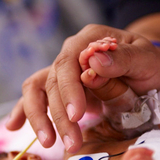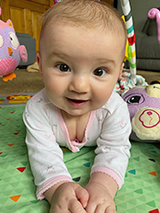Overcoming Feeding Issues from Congenital Diaphragmatic Hernia: Maggie’s Story
Overcoming Feeding Issues from Congenital Diaphragmatic Hernia: Maggie’s Story
When Lisa first learned at 29 weeks that the child she was expecting had a hole in her diaphragm, she felt hopeless. After speaking with a fetal therapy coordinator at the Center for Fetal Diagnosis and Treatment, her hope was restored. Her daughter Maggie’s first few months of life have had ups and downs, but Lisa and her family are blown away by all she’s overcome and are beyond grateful to watch her grow and thrive.

Lisa and her husband Brian felt blessed to be expecting their third child. After suffering four losses prior to their oldest daughter being born, Lisa was relieved that this pregnancy appeared to be progressing as her previous two pregnancies had. Her 20-week anatomy scan showed a healthy, typically developing baby. It wasn’t until a routine prenatal visit at 24 weeks when Lisa felt concerned. Her nurse practitioner reported that she felt the baby was measuring small on clinical exam.
At 26 weeks, a repeat ultrasound showed that the baby’s growth was on target, but there was concern for a possible hernia. The obstetrician referred Lisa to a maternal-fetal medicine specialist (MFM) near her home in Montgomery County, Pa. At 29 weeks, Lisa met with the MFM and underwent another ultrasound alone while her husband waited patiently in the car due to COVID precautions. Following the ultrasound, Lisa and Brian both sat with the doctor as he confirmed what they feared most: their baby had a left-sided congenital diaphragmatic hernia (CDH). Lisa and Brian went numb.
Getting to the right place, quickly
“The prognosis felt very grim,” Lisa recounts. With Lisa and Brian still in the office, the MFM immediately contacted the Center for Fetal Diagnosis and Treatment at Children’s Hospital of Philadelphia (CHOP) to refer them for a comprehensive evaluation.
“Making that phone call was the best thing he did for us,” Lisa says of the doctor. The Center has the world’s largest experience diagnosing, understanding and treating fetuses and babies with CDH. Less than an hour later, a call from one of the Center’s fetal therapy coordinators restored the family’s hope.
“She was wonderful,” says Lisa of the fetal therapy nurse coordinator. “Everything I read online up until this point was very scary. She told me to stop Googling and just read the information on the CHOP website. Once I did that, everything changed. She gave me hope again.” Thanks to the timeliness of that initial call, and a little bit of luck, the nurse coordinator was able to schedule Lisa and Brian for a full-day evaluation the very next day.

Why choose CHOP
CDH is an extremely complex condition that requires delicate care. Comprehensive management by an experienced team is vital — here's what you can expect at CHOP.
Lisa and Brian arrived at CHOP at 6:30 a.m. for their full-day evaluation. At the end of the day, they sat down with their team of doctors to review their baby’s unique findings. High-resolution ultrasound and fetal MRI — specialized imaging pioneered by the Center’s team — showed the fetus’s stomach had moved through the hole in the diaphragm and up into the chest. There was a fluid-filled bubble around the fetus’s stomach and the stomach was relatively distended and somewhat thick-walled with an orientation that raised concern for volvulus, a condition in which the intestine twists around itself and obstructs the bowels.
Follow-up and special delivery
The team recommended Lisa return for weekly follow-up appointments to monitor the fluid-filled bubble. Fortunately, the bubble’s size remained stable and the fetus grew well for the remainder of the pregnancy.
Lisa gave birth to Maggie in the Garbose Family Special Delivery Unit (SDU) at 38 weeks’ gestation. “I can’t say enough good things about it,” says Lisa. “Everyone was great.”
The SDU was designed to be able to stabilize babies with birth defects in an adjacent room by an expert neonatal surgical team. At birth, Maggie immediately required a breathing tube. After having the tube placed, her parents were able to meet her before she was taken to the nearby Harriet and Ronald Lassin Newborn/Infant Intensive Care Unit (N/IICU).
Just two days later, Maggie was stable enough to undergo surgical repair of the hole in her diaphragm. She came off breathing support two days later and was able to breathe completely on her own. While Maggie’s medical team told Brian and Lisa that this was an atypically rapid progression for weaning respiratory support in babies with CDH, they were preparing for a longer journey to feeding tolerance.
Overcoming feeding struggles associated with CDH
Maggie’s biggest hurdle to overcome was feeding. Infants with CDH are at an increased risk for feeding difficulties. There are likely many reasons for this, including increased calorie needs related to pulmonary hypoplasia (underdeveloped lungs), higher energy needs to compensate for the increased effort needed to breathe, pulmonary hypertension and wound healing.
Many infants and children born with CDH need a feeding tube to help them grow and develop. Oral aversions are common due to medical interventions during the N/IICU stay (e.g., intubation) and the presence of GERD and dysmotility, in which muscles in the digestive system don’t work as they should. CHOP’s dedicated dietitians provide specialized counseling to develop individual plans to meet each child’s nutritional needs, through tube feedings, oral feedings or a combination of both, to attain optimal growth and development.
Maggie spent six weeks in the N/IICU. Her first primary nutrition source was total parenteral nutrition (TPN), a method of feeding essential nutrients that bypasses the gastrointestinal tract and is given through a vein.
She initially trialed food by mouth in the first week after surgery without complications, but she had difficulty keeping the breast milk down. Because of her frequent vomiting, her next source of nutrition was a nasoduodenal (ND) tube, which is passed through the nose and bypasses the stomach. The goal was for Maggie to take as much breast milk by mouth as tolerated, with any additional needs supplemented by the feeding tube. After several days with frequent vomiting episodes, however, it was decided that Maggie would need a nasojejunal (NJ) feeding tube instead. This feeding tube requires placement in CHOP’s Interventional Radiology department as it is passed through the nose and directly into the small intestine.
The plan was to use the NJ tube as Maggie’s primary nutrition source and trial small amounts of breast milk by mouth. But Maggie struggled to keep the milk down and subsequently suffered from poor weight gain.
“It was one of the hardest things to watch our baby who seemed to love to eat not be able to keep her food down,” says Lisa. “There was nothing we could do to help her.”
Maggie also had a small hiatal hernia, which is when a portion of the stomach slips into the middle compartment of the chest contributing to her reflux symptoms and feeding challenges.

With this new information, the medical team trialed Maggie on a new medication regimen to promote her gastric motility and help keep the breastmilk down in the stomach, reducing the vomiting. After a couple of weeks of gradually increasing the volume of breastmilk Maggie took by mouth, they were able to reduce the volume of milk she took through the NJ tube. Maggie eventually tolerated all of her feeds by mouth alone, requiring no supplemental nutrition by the feeding tube. The patience of Maggie’s parents and her team allowed her to avoid another operation!
“We always thought she would be coming home on a feeding tube,” Lisa says. “We were in absolute disbelief to bring her home eating by mouth!”
Maggie is now 5 months old. She has been eating by mouth for months and steadily gaining weight. The plan is to start her on solid foods in a couple of weeks, and, if that goes well, begin to wean her off the medications.
“Everything has improved,” says Lisa. “Maggie is now even nursing and taking bottles and gaining weight like a champ. It’s kind of mind blowing. She’s a miracle in every way.”